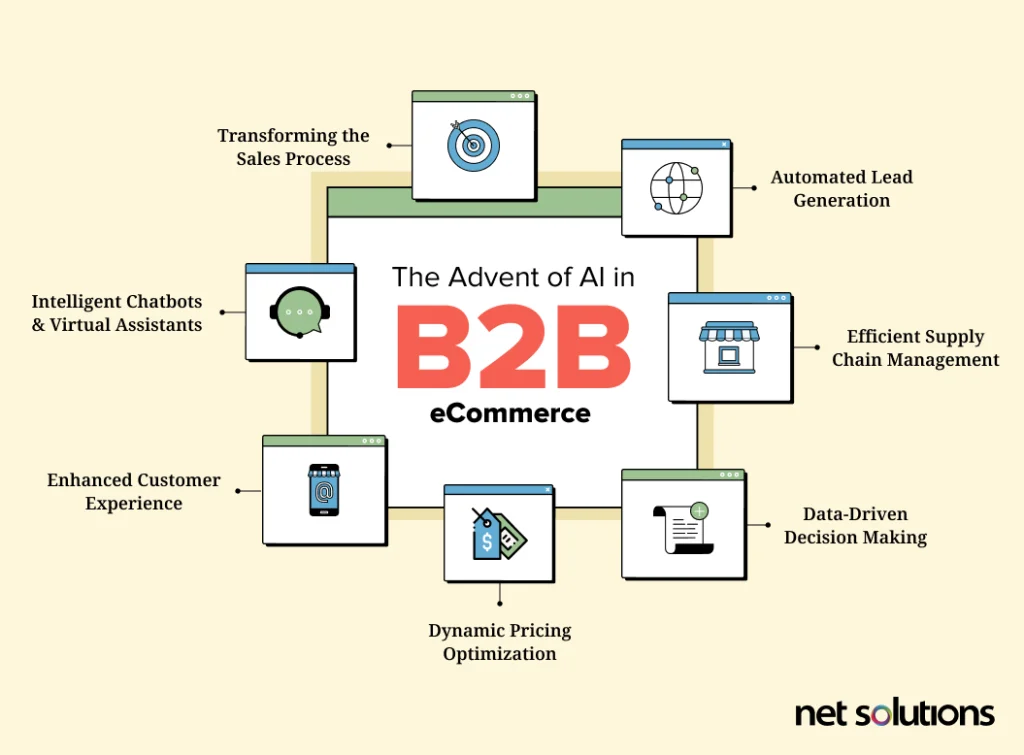How AI Automation For B2B minimizes human error in business processes
AI Automation for B2B: Strategies to Improve Your Business Efficiency
AI automation in the B2B market presents a crucial opportunity for companies to enhance their performance. By improving and simplifying processes decision-making, services can attain significant effectiveness. However, the successful combination of AI calls for careful factor to consider of numerous factors. Understanding which areas to automate and picking appropriate devices are just the start. The potential for improvement raises essential concerns concerning implementation and continuous examination. What approaches will guarantee long lasting success in this advancing landscape?
Recognizing AI Automation in B2B Context
As businesses progressively seek performance and technology, understanding AI automation in the B2B context becomes crucial. AI automation leverages innovative technologies to streamline processes, enhance decision-making, and enhance total productivity. By incorporating AI devices, companies can maximize procedures such as supply chain monitoring, consumer partnership monitoring, and information analysis. These innovations can examine substantial quantities of information quickly, offering workable understandings that drive critical campaigns. Furthermore, AI-driven automation decreases human error and maximizes employees to concentrate on even more complicated tasks. By cultivating cooperation in between human intelligence and machine capabilities, organizations can accomplish an one-upmanship. Inevitably, recognizing AI automation is vital for B2B organizations intending to prosper in a significantly digital marketplace.
Recognizing Areas for Automation
In the pursuit for efficient AI automation in B2B, it is necessary to determine specific locations where automation can produce considerable advantages. This consists of reviewing job monotone, checking out chances for data processing, and pinpointing workflow traffic jams. By concentrating on these aspects, organizations can simplify procedures and enhance performance.
Task Monotone Analysis
Job repetitiveness analysis plays a necessary function in determining areas ripe for automation within B2B procedures. Minarik AI. This procedure involves examining day-to-day jobs to determine which are repetitive and time-consuming, thus hindering efficiency (AI Automation For B2B). By scrutinizing process, businesses can determine particular features that need too much hands-on input, such as information entry, billing processing, or customer follow-ups. Recognizing these recurring tasks permits organizations to allot resources a lot more effectively, improving total effectiveness. In addition, automation can minimize human mistake, streamline operations, and free up workers to concentrate on higher-value activities. Performing a comprehensive task monotone assessment equips B2B companies to adopt targeted automation methods, ultimately driving improved efficiency and competitive benefit in the market
Information Processing Opportunities

Workflow Traffic Jam Recognition
Determining operations traffic jams is a vital action in recognizing the full benefits of automation within B2B companies. These traffic jams typically materialize as hold-ups, source constraints, or inefficient processes that impede performance. To effectively determine these areas, companies can perform thorough evaluations of their process, utilizing metrics such as cycle time and throughput. Involving workers in conversations regarding pain factors can also provide beneficial insights. When bottlenecks are identified, companies can prioritize them based on effect and feasibility for automation. By purposefully resolving these ineffectiveness, B2B business can streamline procedures, improve collaboration, and eventually boost general efficiency. This positive strategy to operations evaluation prepares for effective automation initiatives that drive service growth.
Picking the Right AI Equipment and Technologies
As organizations increasingly transform to AI to boost their operations, selecting the right devices and modern technologies becomes necessary for achieving preferred end results. Organizations should review their specific requirements and purposes, considering aspects such as scalability, user-friendliness, and compatibility. A complete market analysis can help identify leading AI options tailored for their industry. In addition, organizations should evaluate the technical infrastructure needed to support these tools, making sure smooth combination with existing systems. Information safety and conformity with guidelines are additionally essential factors to consider that affect device option. By concentrating on these standards, companies can make informed decisions that drive efficiency and efficiency, eventually leading to improved service performance. The ideal AI tools equip companies to innovate and keep a competitive side in the market.
Developing a Critical Application Strategy
An effective strategic implementation plan for AI automation in B2B requires plainly specified vital goals. Furthermore, organizations should evaluate their current capabilities to determine gaps and opportunities for enhancement. Continual tracking and modification of the strategy will assure positioning with developing company demands and technology innovations.
Define Secret Purposes
To guarantee successful AI automation in B2B atmospheres, defining crucial goals is crucial for establishing a strategic execution plan. Organizations needs to determine specific, quantifiable objectives that line up with their general service strategy. This clarity gives a roadmap for the automation process, making certain that efforts are concentrated on areas that will produce the highest effect. Trick goals might include enhancing operational performance, boosting client satisfaction, or raising profits. Setting these purposes makes it possible for teams to focus on resources properly and track progress gradually. Additionally, clear purposes help with far better interaction among stakeholders, cultivating collaboration and alignment throughout the company. Eventually, distinct objectives work as the foundation for a durable AI automation technique that drives service performance.
Examine Current Capacities
Prior to carrying out AI automation, organizations should completely examine their existing capacities to identify strengths and weaknesses. This analysis involves examining existing technologies, workforce skills, and operational procedures. By performing a thorough audit, organizations can determine locations that call for renovation or financial investment. Organizations should likewise consider their data monitoring methods, as the top quality and access of information are vital for effective AI assimilation. Understanding the present technical landscape makes it possible for firms to straighten their sources and capabilities with their critical objectives. Furthermore, it is vital to evaluate business society and preparedness for adjustment, as these factors considerably influence the fostering of AI remedies. This evaluation works as the foundation for creating a calculated implementation strategy that optimizes the capacity of AI automation.
Monitor and Change
Implementing AI automation calls for a dynamic method that emphasizes continual surveillance and change. Services need to develop a strategic execution strategy that integrates normal examinations of AI performance versus predefined metrics. This entails tracking essential performance indicators (KPIs) to assess the performance of automation remedies. By assessing information, companies can recognize locations for renovation and adjust their AI systems appropriately. Engaging with stakeholders throughout the procedure guarantees that the automation lines up with organization purposes and user requirements. Furthermore, cultivating a culture of versatility permits companies to respond promptly to changing market conditions and technical advancements. Growth Systems For B2B. Inevitably, ongoing tracking and modification not just boost operational efficiency however likewise drive continual organization performance in the competitive B2B landscape
Ensuring Data High Quality and Assimilation
As organizations increasingly depend on AI automation in B2B procedures, ensuring data high quality and combination comes to be important Source for success. High-quality data is vital for exact analytics, informed decision-making, and efficient consumer engagement. Data should be cleaned up, standard, and confirmed to eliminate errors and variances that might bring about misguided understandings. In addition, smooth assimilation throughout various systems and systems is vital; inconsonant information silos prevent automation initiatives and minimize operational effectiveness. Organizations ought to embrace robust data governance structures and use advanced devices to promote information integration while maintaining top quality requirements. By prioritizing these elements, organizations can improve their AI automation efforts, ultimately leading to improved efficiency and an affordable advantage in the B2B landscape.
Gauging Success and ROI of AI Initiatives
Exactly how can organizations successfully measure the success and return on financial investment (ROI) of their AI efforts? To gauge effectiveness, services must establish clear, quantifiable objectives aligned with strategic objectives. Secret efficiency indications (KPIs) such as expense savings, income growth, and efficiency enhancements can offer useful understandings. Organizations commonly carry out standard analyses prior to carrying out AI, allowing them to compare pre- and post-implementation metrics. In addition, evaluating customer contentment and engagement can disclose the impact of AI on individual experience. Frequently assessing these metrics helps in refining AI approaches and guaranteeing positioning with business objectives. By using a structured strategy to dimension and evaluation, organizations can properly assess the efficiency of their AI campaigns and make educated decisions regarding future financial investments.
Getting Over Challenges in AI Adoption
Lots of companies recognize the potential of AI to transform their procedures, they commonly encounter significant difficulties throughout fostering - AI Automation For B2B. Trick hurdles consist of a lack of knowledgeable workers, which interferes with the efficient execution and management of AI innovations. Organizations additionally deal with assimilation problems, as existing systems might not be suitable with new AI remedies. In addition, worries regarding information personal privacy and safety can result in resistance in totally embracing AI capabilities. Resistance to change from employees can even more complicate the shift, requiring detailed training and interaction approaches. To overcome these challenges, companies should purchase talent development, guarantee robust data governance, and foster a culture that embraces development, inevitably leading the way for successful AI integration and enhanced business performance
Regularly Asked Concerns
Exactly How Can AI Automation Improve Customer Partnership Administration in B2B?
AI automation can enhance consumer connection management in B2B by simplifying communication, offering customized interactions, assessing consumer data for understandings, automating follow-ups, and enhancing reaction times, ultimately cultivating stronger partnerships and driving sales growth.
What Industries Advantage A Lot Of From AI Automation in B2B?
Production, financing, medical care, and logistics markets benefit most from AI automation in B2B. These markets leverage automation to simplify processes, boost data analysis, boost customer communications, and ultimately enhance operational efficiency and profitability.
Just How Does AI Automation Influence Staff Member Duty in B2B Firms?
AI automation transforms worker duties in B2B companies by enhancing jobs, reducing repeated job, and making it possible for staff to concentrate on critical initiatives. This shift improves performance and fosters a culture of technology and adaptability.
What Are the Costs Connected With Applying AI Automation?
The costs connected with carrying out AI automation consist of initial software application purchase, framework upgrades, training expenditures, ongoing upkeep, and prospective assimilation obstacles. Minarik AI. Firms need to additionally think about lasting functional shifts and staff member adaptation costs in their financial planning
Just How Can Companies Make Certain Ethical AI Use in Their Procedures?
Services can assure honest AI usage by establishing clear standards, advertising transparency, performing routine audits, including diverse stakeholders, and prioritizing information privacy. Continuous training and understanding programs additionally enhance understanding and adherence to ethical techniques.
